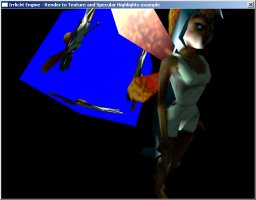
This tutorial shows how to render to a texture using Irrlicht. Render to texture is a feature with which it is possible to create nice special effects. In addition, this tutorial shows how to enable specular highlights.
In the beginning, everything as usual. Include the needed headers, ask the user for the rendering driver, create the Irrlicht Device:
#include <irrlicht.h> #include "driverChoice.h" using namespace irr; #ifdef _MSC_VER #pragma comment(lib, "Irrlicht.lib") #endif int main() { // ask user for driver video::E_DRIVER_TYPE driverType=driverChoiceConsole(); if (driverType==video::EDT_COUNT) return 1; // create device and exit if creation failed IrrlichtDevice *device = createDevice(driverType, core::dimension2d<u32>(640, 480), 16, false, false); if (device == 0) return 1; // could not create selected driver. video::IVideoDriver* driver = device->getVideoDriver(); scene::ISceneManager* smgr = device->getSceneManager(); gui::IGUIEnvironment* env = device->getGUIEnvironment();
Now, we load an animated mesh to be displayed. As in most examples, we'll take the fairy md2 model. The difference here: We set the shininess of the model to a value other than 0 which is the default value. This enables specular highlights on the model if dynamic lighting is on. The value influences the size of the highlights.
// load and display animated fairy mesh scene::IAnimatedMeshSceneNode* fairy = smgr->addAnimatedMeshSceneNode( smgr->getMesh("../../media/faerie.md2")); if (fairy) { fairy->setMaterialTexture(0, driver->getTexture("../../media/faerie2.bmp")); // set diffuse texture fairy->setMaterialFlag(video::EMF_LIGHTING, true); // enable dynamic lighting fairy->getMaterial(0).Shininess = 20.0f; // set size of specular highlights fairy->setPosition(core::vector3df(-10,0,-100)); fairy->setMD2Animation ( scene::EMAT_STAND ); }
To make specular highlights appear on the model, we need a dynamic light in the scene. We add one directly in vicinity of the model. In addition, to make the model not that dark, we set the ambient light to gray.
// add white light smgr->addLightSceneNode(0, core::vector3df(-15,5,-105), video::SColorf(1.0f, 1.0f, 1.0f)); // set ambient light smgr->setAmbientLight(video::SColor(0,60,60,60));
The next is just some standard stuff: Add a test cube and let it rotate to make the scene more interesting. The user defined camera and cursor setup is made later on, right before the render loop.
// create test cube scene::ISceneNode* test = smgr->addCubeSceneNode(60); // let the cube rotate and set some light settings scene::ISceneNodeAnimator* anim = smgr->createRotationAnimator( core::vector3df(0.3f, 0.3f,0)); test->setPosition(core::vector3df(-100,0,-100)); test->setMaterialFlag(video::EMF_LIGHTING, false); // disable dynamic lighting test->addAnimator(anim); anim->drop(); // set window caption device->setWindowCaption(L"Irrlicht Engine - Render to Texture and Specular Highlights example");
To test out the render to texture feature, we need a render target texture. These are not like standard textures, but need to be created first. To create one, we call IVideoDriver::addRenderTargetTexture() and specify the size of the texture. Please don't use sizes bigger than the frame buffer for this, because the render target shares the zbuffer with the frame buffer. Because we want to render the scene not from the user camera into the texture, we add another fixed camera to the scene. But before we do all this, we check if the current running driver is able to render to textures. If it is not, we simply display a warning text.
// create render target video::ITexture* rt = 0; scene::ICameraSceneNode* fixedCam = 0; if (driver->queryFeature(video::EVDF_RENDER_TO_TARGET)) { rt = driver->addRenderTargetTexture(core::dimension2d<u32>(256,256), "RTT1"); test->setMaterialTexture(0, rt); // set material of cube to render target // add fixed camera fixedCam = smgr->addCameraSceneNode(0, core::vector3df(10,10,-80), core::vector3df(-10,10,-100)); } else { // create problem text gui::IGUISkin* skin = env->getSkin(); gui::IGUIFont* font = env->getFont("../../media/fonthaettenschweiler.bmp"); if (font) skin->setFont(font); gui::IGUIStaticText* text = env->addStaticText( L"Your hardware or this renderer is not able to use the "\ L"render to texture feature. RTT Disabled.", core::rect<s32>(150,20,470,60)); text->setOverrideColor(video::SColor(100,255,255,255)); } // add fps camera scene::ICameraSceneNode* fpsCamera = smgr->addCameraSceneNodeFPS(); fpsCamera->setPosition(core::vector3df(-50,50,-150)); // disable mouse cursor device->getCursorControl()->setVisible(false);
Nearly finished. Now we need to draw everything. Every frame, we draw the scene twice. Once from the fixed camera into the render target texture and once as usual. When rendering into the render target, we need to disable the visibility of the test cube, because it has the render target texture applied to it. That's it, wasn't too complicated I hope. :)
int lastFPS = -1; while(device->run()) if (device->isWindowActive()) { driver->beginScene(true, true, 0); if (rt) { // draw scene into render target // set render target texture driver->setRenderTarget(rt, true, true, video::SColor(0,0,0,255)); // make cube invisible and set fixed camera as active camera test->setVisible(false); smgr->setActiveCamera(fixedCam); // draw whole scene into render buffer smgr->drawAll(); // set back old render target // The buffer might have been distorted, so clear it driver->setRenderTarget(0, true, true, 0); // make the cube visible and set the user controlled camera as active one test->setVisible(true); smgr->setActiveCamera(fpsCamera); } // draw scene normally smgr->drawAll(); env->drawAll(); driver->endScene(); // display frames per second in window title int fps = driver->getFPS(); if (lastFPS != fps) { core::stringw str = L"Irrlicht Engine - Render to Texture and Specular Highlights example"; str += " FPS:"; str += fps; device->setWindowCaption(str.c_str()); lastFPS = fps; } } device->drop(); // drop device return 0; }